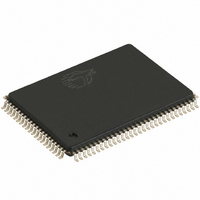CY7C1371D-100AXC Cypress Semiconductor Corp, CY7C1371D-100AXC Datasheet - Page 13

CY7C1371D-100AXC
Manufacturer Part Number
CY7C1371D-100AXC
Description
IC SRAM 18MBIT 100MHZ 100LQFP
Manufacturer
Cypress Semiconductor Corp
Type
Synchronousr
Datasheet
1.CY7C1373D-100AXC.pdf
(33 pages)
Specifications of CY7C1371D-100AXC
Memory Size
18M (512K x 36)
Package / Case
100-LQFP
Format - Memory
RAM
Memory Type
SRAM - Synchronous
Speed
100MHz
Interface
Parallel
Voltage - Supply
3.135 V ~ 3.6 V
Operating Temperature
0°C ~ 70°C
Access Time
8.5 ns
Maximum Clock Frequency
100 MHz
Supply Voltage (max)
3.6 V
Supply Voltage (min)
3.135 V
Maximum Operating Current
175 mA
Maximum Operating Temperature
+ 70 C
Minimum Operating Temperature
0 C
Mounting Style
SMD/SMT
Number Of Ports
4
Operating Supply Voltage
3.3 V
Memory Configuration
1M X 18 / 512K X 36
Clock Frequency
100MHz
Supply Voltage Range
3.135V To 3.6V
Memory Case Style
TQFP
No. Of Pins
100
Rohs Compliant
Yes
Density
18Mb
Access Time (max)
8.5ns
Sync/async
Synchronous
Architecture
SDR
Clock Freq (max)
100MHz
Operating Supply Voltage (typ)
3.3V
Address Bus
19b
Package Type
TQFP
Operating Temp Range
0C to 70C
Supply Current
175mA
Operating Supply Voltage (min)
3.135V
Operating Supply Voltage (max)
3.6V
Operating Temperature Classification
Commercial
Mounting
Surface Mount
Pin Count
100
Word Size
36b
Number Of Words
512K
Lead Free Status / RoHS Status
Lead free / RoHS Compliant
Lead Free Status / RoHS Status
Lead free / RoHS Compliant, Lead free / RoHS Compliant
Other names
428-1631
Available stocks
Company
Part Number
Manufacturer
Quantity
Price
Company:
Part Number:
CY7C1371D-100AXC
Manufacturer:
CYPRESS
Quantity:
465
Company:
Part Number:
CY7C1371D-100AXC
Manufacturer:
Cypress Semiconductor Corp
Quantity:
10 000
Company:
Part Number:
CY7C1371D-100AXCT
Manufacturer:
Cypress Semiconductor Corp
Quantity:
10 000
IEEE 1149.1 Serial Boundary Scan (JTAG)
The CY7C1371D/CY7C1373D incorporates a serial boundary
scan test access port (TAP).This part is fully compliant with
1149.1. The TAP operates using JEDEC-standard 3.3 V or 2.5 V
IO logic levels.
The CY7C1371D/CY7C1373D contains a TAP controller,
instruction register, boundary scan register, bypass register, and
ID register.
Disabling the JTAG Feature
It is possible to operate the SRAM without using the JTAG
feature. To disable the TAP controller, TCK must be tied LOW
(V
internally pulled up and may be unconnected. They may
alternately be connected to V
must be left unconnected. Upon power-up, the device is up in a
reset state which does not interfere with the operation of the
device.
TAP Controller State Diagram
The 0/1 next to each state represents the value of TMS at the
rising edge of TCK.
Test Access Port (TAP)
Test Clock (TCK)
The test clock is used only with the TAP controller. All inputs are
captured on the rising edge of TCK. All outputs are driven from
the falling edge of TCK.
Test Mode Select (TMS)
The TMS input is used to give commands to the TAP controller
and is sampled on the rising edge of TCK. It is allowable to leave
this ball unconnected if the TAP is not used. The ball is pulled up
internally, resulting in a logic HIGH level.
Document Number: 38-05556 Rev. *I
SS
1
0
) to prevent clocking of the device. TDI and TMS are
TEST-LOGIC
RUN-TEST/
RESET
IDLE
0
1
1
0
CAPTURE-DR
UPDATE-DR
PAUSE-DR
EXIT1-DR
EXIT2-DR
DR-SCAN
SHIFT-DR
1
SELECT
0
0
1
0
1
1
DD
0
through a pull up resistor. TDO
1
1
0
0
1
0
CAPTURE-IR
UPDATE-IR
PAUSE-IR
1
IR-SCAN
SHIFT-IR
EXIT1-IR
EXIT2-IR
SELECT
0
0
1
0
1
1
0
1
1
0
0
Test Data-In (TDI)
The TDI ball is used to serially input information into the registers
and can be connected to the input of any of the registers. The
register between TDI and TDO is chosen by the instruction that
is loaded into the TAP instruction register. For information on
loading the instruction register, see TAP Controller State
Diagram. TDI is internally pulled up and can be unconnected if
the TAP is unused in an application. TDI is connected to the most
significant bit (MSB) of any register. (See
Diagram.)
Test Data-Out (TDO)
The TDO output ball is used to serially clock data-out from the
registers. The output is active depending upon the current state
of the TAP state machine. The output changes on the falling edge
of TCK. TDO is connected to the least significant bit (LSB) of any
register. (See
TAP Controller Block Diagram
Performing a TAP Reset
A RESET is performed by forcing TMS HIGH (V
edges of TCK. This RESET does not affect the operation of the
SRAM and may be performed while the SRAM is operating.
At power-up, the TAP is reset internally to ensure that TDO
comes up in a high Z state.
TAP Registers
Registers are connected between the TDI and TDO balls and
allow data to be scanned into and out of the SRAM test circuitry.
Only one register can be selected at a time through the
instruction register. Data is serially loaded into the TDI ball on the
rising edge of TCK. Data is output on the TDO ball on the falling
edge of TCK.
Instruction Register
Three-bit instructions can be serially loaded into the instruction
register. This register is loaded when it is placed between the TDI
and TDO balls as shown in the
Upon power-up, the instruction register is loaded with the
IDCODE instruction. It is also loaded with the IDCODE
TMS
TCK
TDI
Selection
Circuitry
TAP Controller State
Boundary Scan Register
Identification Register
31
x
Instruction Register
TAP CONTROLLER
30
.
29
Bypass Register
.
.
.
.
.
.
.
TAP Controller Block
2
2
2
Diagram.)
1
1
1
0
0
0
0
TAP Controller Block
CY7C1371D
CY7C1373D
Selection
Circuitry
DD
Page 13 of 33
) for five rising
Diagram.
TDO
[+] Feedback













